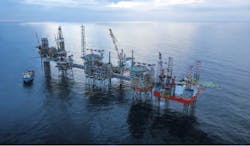North Sea Cygnus to host methane emission trials
Offshore staff
LONDON – Neptune Energy plans to use drone technology in September to monitor methane emissions at the Cygnus gas field complex in the UK southern North Sea.
If trials are successful, the technology could be expanded across the company’s portfolio.
Neptune has also submitted an application to Britain’s Oil and Gas Authority for a carbon dioxide appraisal and storage license. The proposed DelpHYnus development would provide a CO2 transport and storage solution for the South Humber industrial area close to the Yorkshire coast, along with production facilities for low-carbon hydrogen using natural gas from the UK grid.
Discussions are under way with potential partners for the hydrogen plant.
In mid-year, the company expects to finalize the consortium agreement for the PosHYdon green hydrogen pilot project in the Dutch North Sea, and to initiate a topsides feasibility study for the green hydrogen production system.
Around the same time, the L10 quadrant carbon capture and storage feasibility study should be completed.
As for conventional offshore oil and gas developments, the subsea tree system for Neptune’s Duva project in the Norwegian North Sea was installed in March using a subsea service vessel instead of a rig, leading to $12 million of cost savings.
The final drilling campaign for the four production wells began last month, with start-up through the Gjøa platform targeted for this summer.
Elsewhere in the Norwegian sector, Neptune plans further exploration wells this year close to the Dugong and Blasto discoveries on the Dugong Tail and Apodida prospects.
A development well will be drilled at the K9ab-A platform in the Dutch sector in the current quarter, coming onstream later in the year.
Drilling continues on the Maha-2 appraisal well offshore Indonesia, testing the Maha discovery, thought to hold potentially more than 600 bcf of in place. If the well is successful, Maha will likely to be developed as a subsea tieback to the Eni-operated Jangkrik FPU.
05/13/2021
